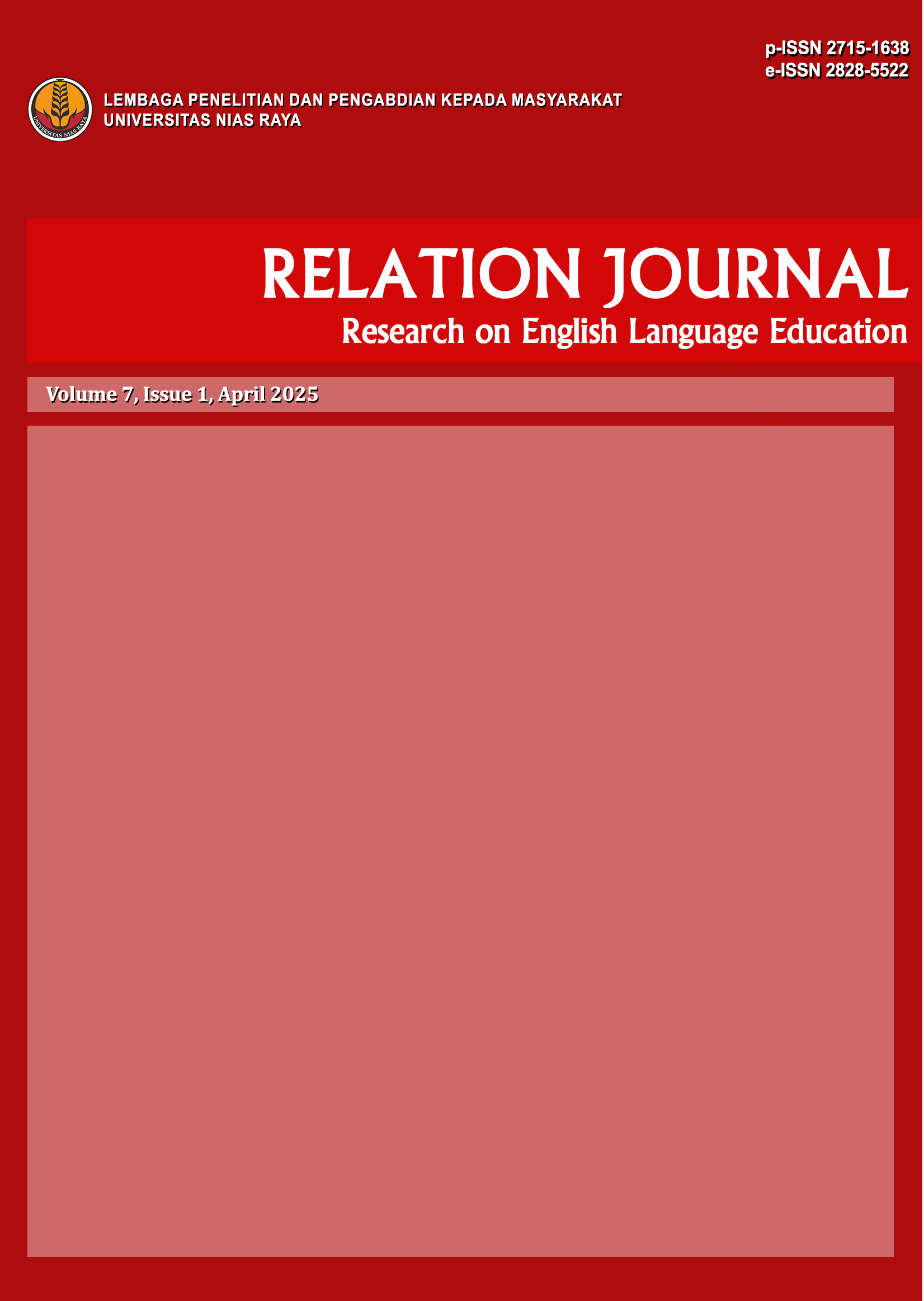STUDENTS’ ERRORS IN THE USE OF SIMPLE PRESENT TENSE IN WRITING DESCRIPTIVE TEXT AT THE ELEVENTH GRADE OF SMA NEGERI 1 TELUKDALAM
Abstract
This study investigated the students’ errors in writing descriptive text especially in the use of simple present tense made by the eleventh grade of SMA Negeri 1 Telukdalam. The objectives of the study were; (1)To describe the students’ errors, and (2)To find out the causes of the students errors. The method used in this study was qualitative method. Total of participants in this study were 34 participants. The result of the data analysis showed that; (1) Students’ errors in writing descriptive text consisted of omission, addition, misformation, and misordering. The students made errors in constructing simple present tense such as errors in constructing verbal and nominal sentences, errors in using to be, errors in applying the suffix s/es and the errors in using pronoun, (2) The causes of the students errors were interlingual and intralingual errors. In conclusion, most of students at the eleventh grade of SMA N. 1 Teluk Dalam made errors in the use of simple present tense of writing descriptive text with the highest error happened in misformation, moderate in addition, next omission and the lowest error happened in misordering. It is suggested to English teachers to improving the method of teaching the simple present tense and how to applying it in writing a text. For the students, it is suggested to learn more about the simple present tense and practice more how to using the simple present tense in conctrusting a text. And, for the next researcher can takes the useful information from this research.
References
Mutolib, A., Rahmat, A., Harefa, D., Nugraha, S., Handoko, L., Sululing, S., Laxmi, & Nurhayati, S. (2025). Volcanic disaster mitigation based on local wisdom: A case study from a local community in the Mount Galunggung, Indonesia. BIO Web of Conferences, 155. https://doi.org/10.1051/bioconf/202515502002
Harefa, D., Sarumaha, M. ., Telaumbanua, K. ., Telaumbanua, T. ., Laia, B. ., & Hulu, F. . (2023). Relationship Student Learning Interest To The Learning Outcomes Of Natural Sciences. International Journal of Educational Research &Amp; Social Sciences, 4(2), 240–246. https://doi.org/10.51601/ijersc.v4i2.614
Harefa, D. (2023). The Relationship Between Students’ Interest In Learning And Mathematics Learning Outcomes. Afore : Jurnal Pendidikan Matematika, 2(2), 1-11. https://doi.org/10.57094/afore.v2i2.1054
Harefa, D. (2024). Exploring Local Wisdom Values Of South Nias For The Development Of A Conservation-Based Science Curriculum. TUNAS : Jurnal Pendidikan Biologi, 5(2), 1-10. https://doi.org/10.57094/tunas.v5i2.2284
Harefa, D. (2024). Preservation Of Hombo Batu: Building Awareness Of Local Wisdom Among The Young Generation Of Nias. HAGA : Jurnal Pengabdian Kepada Masyarakat, 3(2), 1-10. https://doi.org/10.57094/haga.v3i2.2334
Harefa, D. (2024). Strengthening Mathematics And Natural Sciences Education Based On The Local Wisdom Of South Nias: Integration Of Traditional Concepts In Modern Education. HAGA : Jurnal Pengabdian Kepada Masyarakat, 3(2), 63-79. https://doi.org/10.57094/haga.v3i2.2347
Harefa, D. (2024). The Influence Of Local Wisdom On Soil Fertility In South Nias. Jurnal Sapta Agrica, 3(2), 18-28. https://doi.org/10.57094/jsa.v3i2.2333
Harefa, D. (2025). Hombo Batu A Traditional Art That Can Be Explained With The Laws Of Physics. FAGURU: Jurnal Ilmiah Mahasiswa Keguruan, 4(1), 2025. https://jurnal.uniraya.ac.id/index.php/FAGURU
Harefa, D. (2025). Hombo Batu The Tradition Of South Nias That Teaches Courage And Cooperation. FAGURU: Jurnal Ilmiah Mahasiswa Keguruan, 4(1), 2025. https://jurnal.uniraya.ac.id/index.php/FAGURU
Harefa, D., & Fatolosa Hulu. (2024). Mathematics Learning Strategies That Support Pancasila Moral Education: Practical Approaches For Teachers. Afore : Jurnal Pendidikan Matematika, 3(2), 51-60. https://doi.org/10.57094/afore.v3i2.2299
Harefa, D., & I Wayan Suastra. (2024). Mathematics Education Based On Local Wisdom: Learning Strategies Through Hombo Batu. Afore : Jurnal Pendidikan Matematika, 3(2), 1-11. https://doi.org/10.57094/afore.v3i2.2236
Harefa, D., Budi Adnyana, P., Gede, I., Wesnawa, A., Putu, I., & Ariawan, W. (2024). Experiential Learning: Utilizing Local Wisdom Of Nias For Future Generations. CIVIC SOCIETY RESEARCH And EDUCATION: Jurnal Pendidikan Pancasila Dan Kewarganegaraan, 5(2), 52–61. https://doi.org/https://doi.org/10.57094/jpkn.v5i2.2254
Brown. 1987. Principle of Language Learning and Teaching. San Fransisco: Prentice Hall.
Brown. 2004. Language Assesment Principles and Classroom Practices. Longman.
Brown. 2000. Principle of Language Learning and Teaching. New York: Pearson.
Corder. 1981. Error Analysis and Interlanguage. Oxford: Oxford University Press
Chomsky. 2002. On Nature and Language. Cambridge: University New York.
Dulay, Burt, Krashen. 1982. Language Two. New York: Oxford University Press.
Frank. 1972. Modern English. New Jersey: Prentice Hall Inc.
Harmer. 1991. The Practice of English Language Teaching Great. Britain : Longman.
Harmer. 2000. How to Teach English. Longman. Edinburg.
Knapp, Watkins. Genre, Text, Grammar: Technologies for Teaching and Assesing Writing. Australia: University of New South Wales Press, Ltd.
Lincoln, Guba. 1985. Naturalistics Inquiry. Sage Publications, Inc.
Lyons. 1986. Introduction to Theoretical Linguistics.
Mukarto et. al. 2007. English on Sky 1. Erlangga: PT Gelora Aksara Pratama.
Nugrahani. 2014. Metode Penelitian Kualitatif dalam Penelitian Pendidikan Bahasa. Solo: Cakra Books.
Copyright (c) 2025 Fanismawati Lase

This work is licensed under a Creative Commons Attribution-ShareAlike 4.0 International License.
You are free to:
- Share — copy and redistribute the material in any medium or format for any purpose, even commercially.
- Adapt — remix, transform, and build upon the material for any purpose, even commercially.
- The licensor cannot revoke these freedoms as long as you follow the license terms.
Under the following terms:
- Attribution - You must give appropriate credit , provide a link to the license, and indicate if changes were made . You may do so in any reasonable manner, but not in any way that suggests the licensor endorses you or your use.
- No additional restrictions - You may not apply legal terms or technological measures that legally restrict others from doing anything the license permits.
Notices:
- You do not have to comply with the license for elements of the material in the public domain or where your use is permitted by an applicable exception or limitation.
- No warranties are given. The license may not give you all of the permissions necessary for your intended use. For example, other rights such as publicity, privacy, or moral rights may limit how you use the material.









